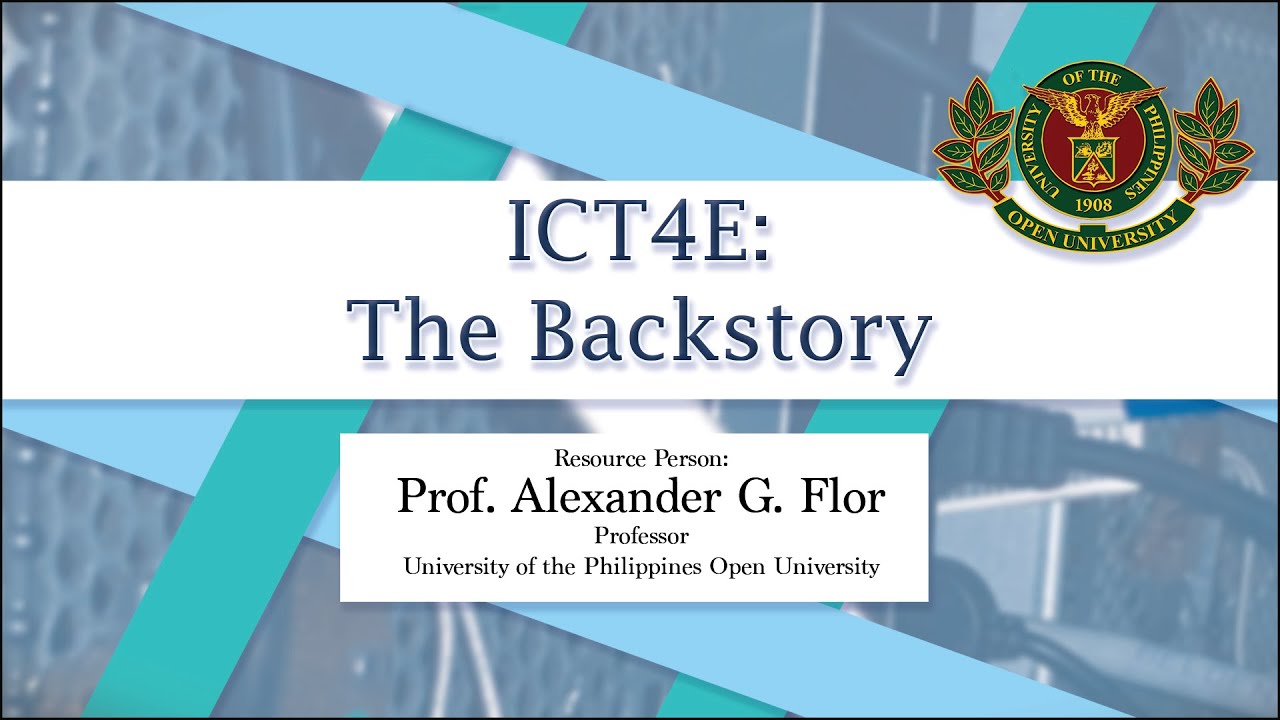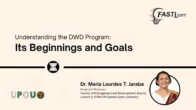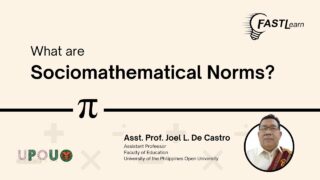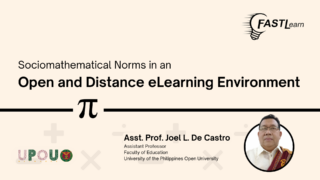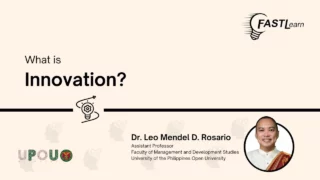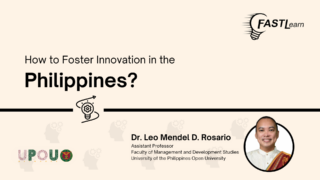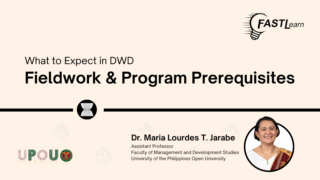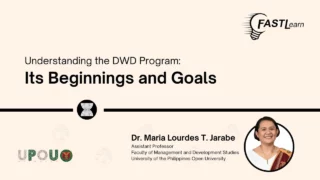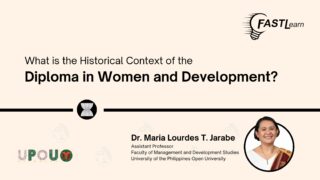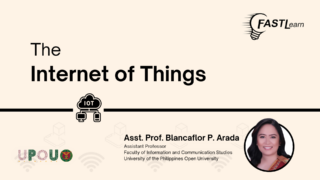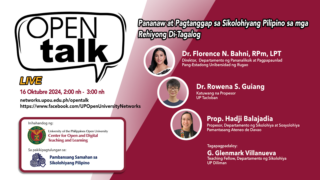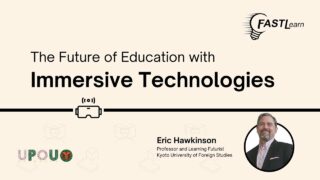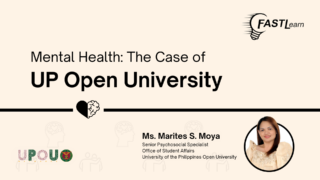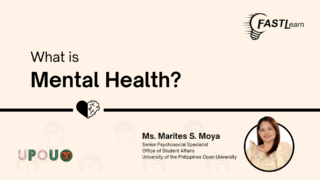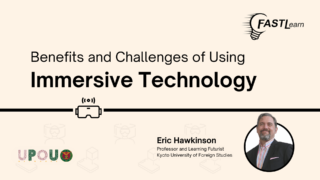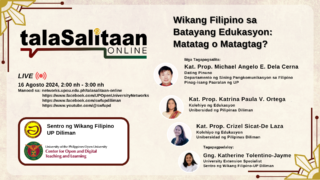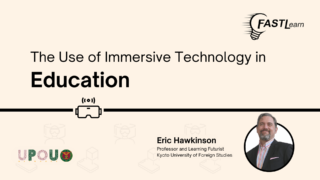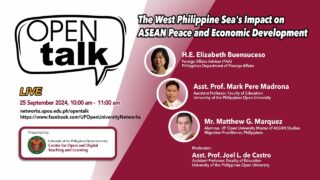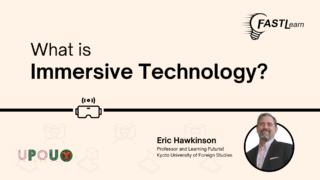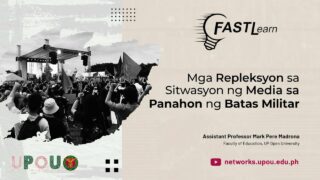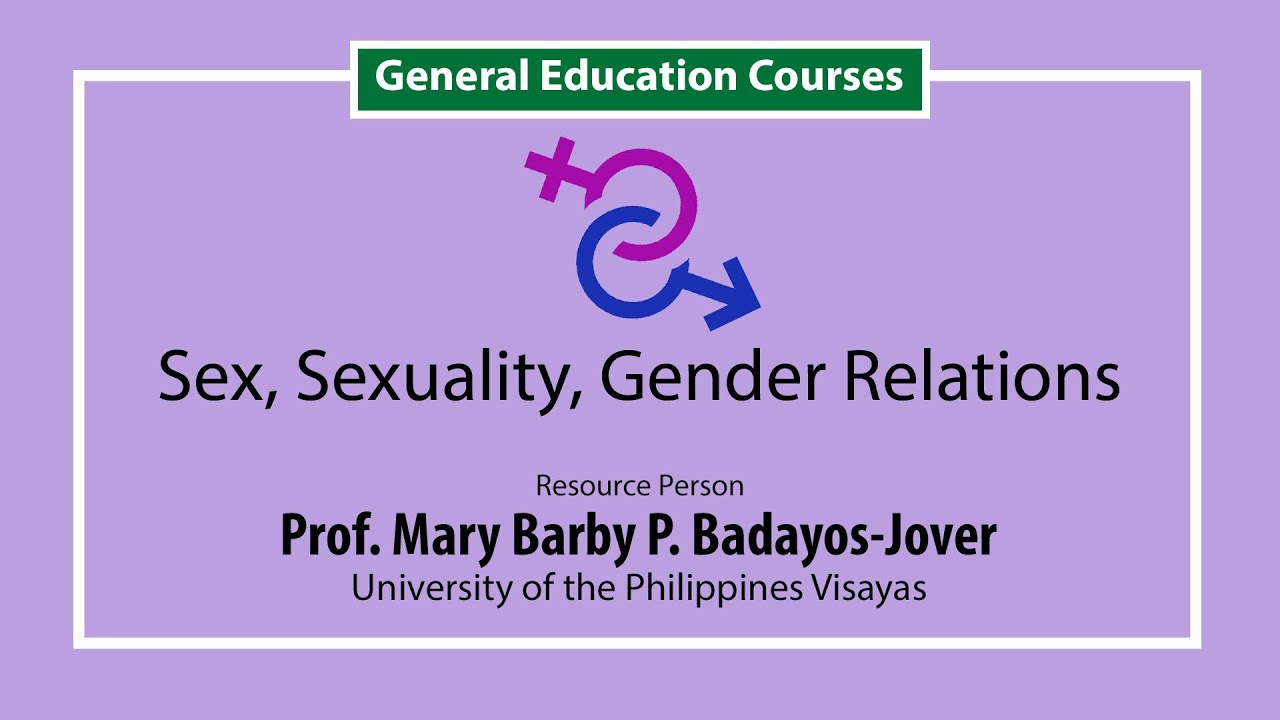Information and Communication Technology for Education (ICT4E):
The BackStory
Dr. Alexander G. Flor
Today, I would like to talk about ICT4E: The Backstory.
ICT4E—meaning, Information Communications Technology for Education. And this is the backstory, sort of a backgrounder of other sessions that would follow on ICT4E policy and standards.
Now, the ICT4E discourse is actually based or is an offshoot of a larger discourse on the information society. Now, many of us think that this discourse started very recently, maybe around ten or fifteen or twenty years ago, but actually the information society traces its roots in economics actually. During the 30’s—post depression 30’s—we could trace it to three Austrian economists. Friedrich Hayek was the first one. If you google his name, you will be provided with the link which leads to this information that he is born in Austria-Hungary as Friendrich August von Hayek and he’s frequently referred to as FA Hayek, an Austrian economist and philosopher best known for his defense of classical liberalism. But actually, he was the person who introduced knowledge economics to the discipline—the economics discipline. Now, again, the backgrounder—consider Germany during the depression; it was being humiliated by the Allies since it lost during the Second World War. And it had to pay outrageous reparations to the allied countries, but then, just prior to the war, it became one of the top ten economies.
Now, how did that happen? Was it because of economic policies of Hitler? No—This fellow, Frienrich Hayek, submitted that it was because of science and technology—it was because of knowledge that Germany earned its place as one of the major economies in the world. And one of his associates, Schumpeter, also from Austria—another one of his associates or actually students is a person by the name of Fritz Machlup. Now, Fritz Machlup emigrated to the United States, and, at the United States, knowledge economics began to be referred to as information economics. Now, he was the person who introduced the trichotomy of the agricultural society, the industrial society, the information society. The term Information Society actually came from him but it was one of his students, Mark Porat, whose 1976 dissertation—a twenty volume dissertation—described the information economy of the US. During Porat’s time, he talked about information economics, information-based economies, industrial-based economies, agricultural-based economies
Now, how is this related—this concept of information society—how is this related to ICT4E? Well, as I said, the ICT4E discourse is an offshoot of this larger discourse called information society. What makes a society an information society? What makes a country an information-based economy? Well, according to Porat, if the larger number of your workforce are information workers, then your country is an information-based economy—it’s an information society. If the larger portion of your workforce are agricultural workers or farmers, then your country is an agricultural society.
Now, is the Philippines an information society?
Well, that just happened to be the subject of my dissertation in 1983, then I found—of course, given secondary data, as well as other sources—that the Philippines is an agricultural society. But in 2007, somehow, our classification was changed from an agricultural, to an industrial, to an information society—that is because our overseas Filipino workers were classified as service workers. Many of them were put into the category of information workers for one reason or another.
Now again, what makes us an information society?
I will show you a graph. Now this graph is called the Volatility Index—The CBOE volatility index—CBOE, meaning, the Chicago Board Of Economics, if I’m not mistaken. Now, this graph shows times when volatility is very high—volatility, meaning, markets—economic markets tend to sell. People have lost trust in their stocks so they sell their stocks. In this graph you would see peaks in 1987 and 2007 or 2008.
Now, a large part of that “peaking up” was due to media coverage of this behavior in the stock market. In 2007, if you’re not too young to remember, people watched CNN or ANC while the value of their stocks fell. And, as this was being covered by [the media], they started selling, selling, selling. So this is, you know, the influence of information and communication in our economy.
Another example—a more recent one—in 15 September 2016, I was on my way to Los Baños along EDSA. I was caught in EDSA traffic, so I switched on the radio. This was at around 10:00AM, and lo and behold, the voice that I heard was the voice of Leila de Lima and Edgar Matobato. And the resource person—it was a senate hearing—the resources person was giving out details of heinous crimes in Davao. And at that time, I was checking the Philippine Stock Exchange index on my phone. So this is a picture of the Philippine Stock Exchange index at 10:00 to 10:30. Now at around 10:00, the witness was giving his testimony and, at that time, the PSE index dropped drastically. Now, at around 10:30, he was interpolated by Senator Tito Sotto. And at that time, when Tito Sotto started putting or was punching holes into his testimonies, the stock index was going higher—it went a bit higher. And [when] de Lima interjected and served as lawyer to the witness again, it went down. Now immediately after that, I got home, I watched TV and then, also, monitored the PSE index on my phone. And this is the image the I got. Now, if you look closely, the ebbs and flows—the speaking and diving of our index coincides with interpolations of Senator Sonny Angara and Senetor Cayetano—actually ending with Cayetano’s interpolation. After his questioning the witness, the index was at the same level as it was before 10:00.
So, you could just imagine how coverage—how media coverage—how information and communication could actually dictate the value of your stock. Such is an information society.
How is this relevant to us in the education sector?
Now, one of the foundations—one of the basic assumptions—of the information society discourse is that information is a commodity that has value. It should be factored into our economic equations. Information is something that can be sold or bought. Counterpoint to that is the open access movement.
Now what you see is the universal symbol for open access. How does it look like? It looks like a padlock, doesn’t it? An open padlock with an “O” in the middle and an “A”, so that’s for Open Access.
Open Access submits that information is free; knowledge is free; it should be accessible to all its users. Now, along that comes the open educational resources. Along the same line, this is what is known as the Creative Commons stamp—the universal symbol for creative commons. If you have copyright then you would have copyleft.
Within the information society discourse is the concept of openness in sharing knowledge. And, what you see now is the coat of arms of the Open University, which refers to the UK Open University. Note that its motto is “Learn and Live”. In 2011, a ranking was made to determine the top 10 research universities [in] the UK. And according to Sir John Daniel, the UK Open University was fifth in that rank. Number one was Cambridge. Number three was the London School of Economics. The fifth was the UK Open University. It outranked even Oxford, which was number six. And, this open university—actually it’s becoming a trend—what you see is the seal of the University of Michigan. The University of Michigan, like the University of the Philippines, has its open university and they call their open university Open Michigan. So perhaps, we should call ourselves Open Philippines or Open UP. There is also this Nottingham University. [It has] its Open Nottingham.
Now, these trends are all offshoots of an Information Society. You must have heard of concept of mega universities. A mega university is a university with a minimum of 100,000 actively enrolled students. This term was, again, coined by Sir John Daniel in 1995. Only 11 such Institution existed by 2011. There were almost 50 mega universities worldwide and an example of a mega university is the University of Phoenix in Phoenix Arizona—perhaps, or arguably the most successful Open University in the United States. And of course, we have our UP Open University. It’s the 5th constituent unit of the University of the Philippines system. It’s UP cyber campus. And, we believe strongly that we pioneered in ICT for education. We established a faculty of Information and Communication Studies in 2004. And, 100% of our courses are offered online.
Also, as educators, we should be aware of what is known as the Paris Message. In 2015, 49 countries converged in Paris to deliver this, so-called, Paris Message to agree, first, and then deliver. Part of the Paris message reads “We call on governments to recognize the important contribution of online open and flexible systems to meet the challenge of scale and quality in the provision of higher education and lifelong learning for the period 2015-2030”
Consider that Paris Message was drafted the same month as the release of the Sustainable Development Goals 2015, 2030, which has one of its major goal lifelong learning and education for all.
The countries who participated in drafting the Paris Message believed that higher educational institutions will not be able to accommodate the uptake of college enrollees by 2030 or even the years towards 2030. There will be a deficit of something like 30 million students who would want to take college. The educational institutions will not be able to accommodate them because of the lack of facilities—the lack of space. And this is the reason why we have to go online. We need to explore or mainstream online Open and Flexible systems.
Yes, ICT is an offshoot of the information society. ICT, meaning, information and communication—others say communications—technology or technologies. Information and communication technologies. It’s a new generation of technologies brought about the merger of computers and telecommunications, internet the world wide web, so on, multimedia
Now in the late 90’s, somebody felt that it should be applied for the development agenda. And so, we have ICT4D—meaning, Information and Communication Technology for Development. This movement originated in the World Bank and eventually UN agencies adopted it, such as UNESCAP and UNESCO, and, as a subcategory or sub field under ICT4D, ICT4E, Information and Communication Technology for Education. In the Philippines, the pioneering institution that went into this is FIT-ED. Now, the UP Open University was quite fortunate that two of FIT-ED’s thought leaders in the early part of the 21st Century were actually part of our faculty—I’m referring, of course, to Dr. Lolit Suplido, who introduce e-learning to UPOU, and Dr. Pat Arinto, who is now the Dean of the Faculty of Education. At around the same time, the CICT was established by the Philippine government.
Now, how did ICT4E get into the Philippine education scene, since the time of FIT-ED and CICT?
Among the intentions of the basic education sector reform agenda in 2006 was to develop an ICT4E strategy for the Philippines. And, there were a number of studies that were conducted that led to this ICT4E strategy. Some of which assumed these proposition that ICT4E programs in the Philippines during that time tended to be technology driven. ICT4E programs tended to be donor driven. And, social realities necessitate the appropriate use of ICTs for education.
Then, ICT4E had three functional areas:
ICT for pedagogy—there was DepEd computerization program, the DTI PCs for public schools project, iSchools, eSkwela, Community eCenters, the ASEAN School Net—consider this was from the period of 2004 to 2007, the APEC ICT model school project, and so on and so forth. There [was a] systematic exploration of the feasibility of e-learning for basic [education], which was yet to be initiated.
The next functional area was ICT for teacher development. There was the CHED initiatives on standards for ICT teacher competencies— I think which is part of this program that is developing is open educational resource, Intel’s teach to the future, FIT-EDs instructional design workshops, etcetera, etcetera.
Third functional area is ICT for governance and management. DepEd then had a number of databases: the Basic Education Information System and others. Now, there were structural issues then. DepEd had no organizational readiness. The current organizational structure of DepEd may not be very conducive to networking. Information and communication flows were stymied instead of flowing freely horizontally, vertically and radially. I understand that, nowadays, there is a move to improve this [in the] internal communications within DepEd. And the symptom was that there were too many channels for too much paperwork. The organizational culture of the department was possibly averse to knowledge sharing and reuse.
There were also political issues, such as interfacing and coordination among the different bureaus. One project would develop its own database another project would develop its own database and [these databases] do not communicate with one another, they cannot exchange data, [and they] cannot merge data.
There were also programmatic issues. There is very little appreciation of primary, secondary and tertiary impacts of ICTs in the development setting. What determines current ICT program design? It’s actually assessment needs or donor agendas. It’s based on social agendas or technologies. The relevance and sustainability would be enhanced if impetus for the project came from a real and felt need
The conclusion of this different studies, then—among these studies [was one which was funded] by CIDS, the Center for Integrative and Development Studies—is that, in spite of clear visioning among ICT4E advocates, programs tend to be insensitive to social realities because of the lack of proper appreciation of higher order impacts of ICTs, donor agency, country agendas, industry agendas, [and structural] issues within DepEd.
And, there are a number of policy instruments that were introduced or proposed. The first one was defining the coverage of ICT to include traditional media—not only those where computers and telecommunications merge. Another policy instrument was an appropriate use policy. The rationale of which was that with that with the adoption of the above definition, what follows is an appropriate use policy that sets efficient and effective utilization guidelines. The next policy instrument that was proposed then was donor coordination and harmonization and public private sector partnerships.
Now, all of these studies—these policy options—all contributed to an ICT4E strategy of the Department of Education which will be one of the topics in a future session.
So, I will end with my favorite point or stanzas from a very old poem:
Endless invention, endless experiment,
Brings knowledge and motion but not of stillness;
Knowledge of speech, but not of silence;
Knowledge of words and ignorance of the Word.
All our knowledge brings us nearer to our ignorance,
All our ignorance brings us nearer to death,
But nearness to death no nearer to God.
Where is the life we have lost in living?
Where is the wisdom we have lost in knowledge?
Where is the knowledge we have lost in information?
The cycles of Heaven in twenty centuries
Brings us nearer or farther from God and nearer to the Dust
—T.S Elliot
[This is a poem] which he wrote in 1934, [entitled, The Rock].
Where is the wisdom we have lost in knowledge? Where is the knowledge we have lost in information? We hope that the educational sector will not be asking these questions to itself.
Thank you very much.


